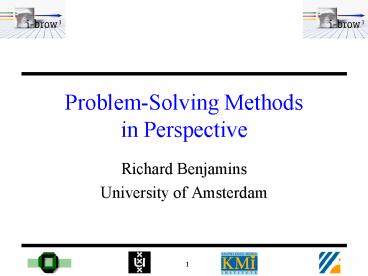ProblemSolving Methods in Perspective - PowerPoint PPT Presentation
1 / 38
Title:
ProblemSolving Methods in Perspective
Description:
Develop an intelligent brokering service that enables third ... ESPRIT, Open Long Term Research. basic research. industrial potential. unknown risk. Partners: ... – PowerPoint PPT presentation
Number of Views:35
Avg rating:3.0/5.0
Title: ProblemSolving Methods in Perspective
1
Problem-Solving Methodsin Perspective
- Richard Benjamins
- University of Amsterdam
2
In perspective?
- Knowledge components
- PSMs and Ontologies
- A standard for characterizing PSMs?
- PSMs in Cyberspace
- From ideas to practice a community effort
3
IBROW
- An Intelligent Brokering Service for
- Knowledge-Component Reuse on the World-Wide Web
Richard Benjamins
4
Objectives of IBROW
- Develop an intelligent brokering service that
enables third party knowledge-component reuse
through the Web - Configurable reasoning services on the web
- Plug Play of PSMs and Ontologies
5
The agents involved
6
Innovative aspects
- Most web services broker static information
- Metacrawler, Searchbroker, Ontobroker
- IBROW brokers dynamic (reasoning) knowledge
- Opens possibility for a new electronic market
place
7
Motivation
- Topdown
- make KE technology on reuse more widely
accessible at lower cost - Bottom up
- several PSM libraries exist, but not accessible
nor interoperable - WWW is here to stay
8
IBROW project
- ESPRIT, Open Long Term Research
- basic research
- industrial potential
- unknown risk
- Partners
- University of Amsterdam, SWI (nl)
- University of Karlsruhe, AIFB (de)
- Open University, KMI (uk)
- Artificial Intelligence Research Institute (es)
9
Approach
- Standard Product Description Language
- Libraries of reusable PSMs and Ontologies
- Brokering problem-solving knowledge
- Interoperability
- User Interface (browser)
10
Overview
- Method description language (UPML)
- Brokering problem-solving knowledge
- Interoperability of heterogeneous components
- Conclusions
11
What is UPML?
- Starting point CML of CommonKADS
- Adds
- component-based software development
- component reuse
- Machine processable
- enables semi-automatic system development
- needed for broker
12
The Backbone of UPML
13
Ontology
- Explicit specification of a conceptualization
- can be shared by multiple reasoning components
- Provide definition of
- signatures
- axioms
- used by other parts of the architecture
14
Task
- Specifies problem to be solved
- by knowledge-based system
- Problem definition is domain independent
- enables reuse of generic problem definitions for
different applications. - contrary to most approaches in software
engineering
15
Domain Models
- Domain knowledge required by
- problem-solving method
- task definition
- Three elements characterization of
- properties
- assumptions
- domain knowledge
16
Problem-Solving Methods
- Describe reasoning steps and types of knowledge
needed to perform a task. - Two different types of PSMs
- complex problem-solving methods
- primitive problem-solving methods
17
Problem-Solving Methods
- Complex problem-solving methods
- decompose a task into subtasks
- Primitive problem-solving methods
- make assumptions about domain knowledge to
perform a reasoning step - do not have an internal structure
18
Problem-solving method
19
Bridges, Refiners
20
Bridges
- Model relationships between two different parts
of an architecture - between domain and task
- task and problem-solving method
21
Refiners
- Used to express the stepwise adaptation of one
type of element of a specification - a task is refined into a more specific task
(design --gt parametric design) - a problem-solving method is refined into a more
specific PSM (search --gt hill climbing)
22
Design Rules
- Architectural constraints ensure well formed
specifications - The individual components must fulfill certain
properties (assumptions operational-spec --gt
competence of PSM) - Their connection via bridges and refiners must
fulfill certain properties
23
Editor for UPML
- PROTEGE-II provides an environment for generating
knowledge acquisition tools - Use of PROTEGE-II for
- defining UPML meta ontology
- designing editor for UPML
24
Meta ontology of UPML
25
Editor for UPML
26
Browser for UPML
- On2broker for
- browsing UPML specifications
- query interface for UPML specifications
- Query Interface is a JavaTM Remote Method
Invocation (RMI) Server which can be consulted by
any software agent
27
The IBROW broker
- Acquire customers problem description
- Configuration
- Find candidate problem-solving methods
- Check their applicability wrt the KB
- Integrate the PSMs into a coherent reasoner
- Execution
- CORBA
- Web standard
28
Two problems
29
Characterizing PSMs
- UPML provides slots for
- competence of PSMs
- goal of tasks
- pragmatics (non functional)
- ease of use
- rate of success
- successfully used in
- assumptions of PSMs, tasks and domains
30
Finding PSMs
- Libraries have to register at the broker
- Global match in case of many PSMs
- pragmatics, keywords
- For promising PSMs, match competence with task
goal (theorem prover) - might imply mapping and renaming
31
Checking applicability
- Check assumptions of the PSM in the KB of the
customer - theorem prover
- If different ontologies, derive bridges to
connect PSM and KB
32
Locating PSMs
33
Integrating PSMs
- Impose control knowledge on the selected PSMs
- chain inputs and outputs
- consider UPMLs operational descriptions
- exploit existing task structures
34
Execution
- CORBA
- the configured problem-solver is a collection of
clients - each PSM is a server
- the KB is a server
- Lisp Server (using Web standards)
- client can also query Lisp Server
- Broker controls which client sends requests
35
Overall picture
36
Small demo
37
Summary of Achievements
- Distributed knowledge-intensive applications
- Competence-oriented component libraries with
explicit models based on a uniform framework - (Semi-) automated construction of bridges between
components and refiners - Interoperability through CORBA and WWW standards
- Powerful brokering facilities
38
Open Issues
- Formalization (pragmatics)
- CORBA wrapping of (legacy) KBs
- Bridges and refiners (theory)
- Architectures































